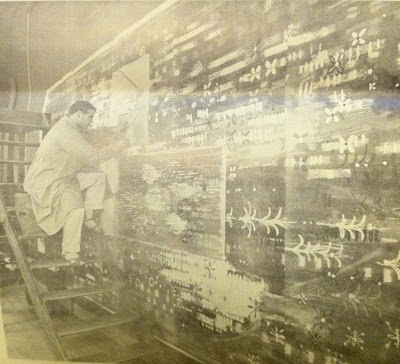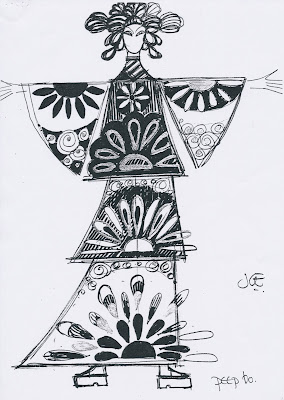Joyce Conwy Evans - ever heard of her? No? Even though she has designed over 18 tapestries and rugs for Dovecot? Thought not. Joyce is an elusive designer, a mystery for many, whose career began well before the internet made everything instantly available to view.
 |
| Joyce in her studio, photo by Elizabeth Cumming |
In November I visited Joyce at her studio in London. There we spent over an hour and a half chatting about everything from Kindles to knitting, with some serious chat about tapestries in between. Joyce's rich colourful style, combined with a deep understanding of what it means to design tapestry, has led me to include her as one of my case studies for my thesis. Joyce's training began with a National Diploma in embroidery at Bromley College. From there she went to the Royal College of Art, London, studying Interior Design as there was no embroidery department at that time. Before setting up her own embroidery and design practice in 1974, she worked for Sir Hugh Casson's architectural practice.
Joyce's first tapestry design commission came from the Hilton hotel group, to design a tapestry for their new Park Lane Hotel. The tapestry was to be 20 feet in height - by Joyce's own admission this was her first encounter with tapestry weaving.
 |
| Design for Spirit of Dance, 1962, for Hilton Park Lane, photo by EC. |
 |
| Press Cutting: a Dovecot weaver creating an outline tracing from an enlarged photocopy of Joyce's design |
The 1960s were busy time for Joyce and Dovecot (then officially known as the Edinburgh Tapestry Company). The Hilton commission was followed a few years later by
The Elements for Eastbourne Water Works and chair upholstery for the
Worshipful Company of Furniture Makers.
 |
| Design for The Elements, 1965 |
At the time of
The Elements, Joyce's style was very similar to what it had been in the Hilton tapestry, and both hangings were woven quite flatly. In 1967 the working relationship with Dovecot became more experimental. Joyce commissioned a small tapestry,
Woodthorpe, for an exhibition she was having at Charterhouse, Godalming. The tapestry design was very complex with layers of motifs, but there was only a short time to weave it. The solution was that the main design was woven by Dovecot, and the rest was embroidered on by staff and students at Edinburgh College of Art.
 |
| Woodthorpe (detail), 1967, photo by EC |
The other development came in the form of a commission from the
Royal College of Art for robe edgings and a trumpet tabard. As with
Woodthorpe, these necessitated a combination of weaving and embroidery. The tapestry parts were woven in Edinburgh, then Joyce and her colleagues applied them to the robes, using embroidery and ribbon to conceal the joins. Joyce was amazed when Archie came up with the suggestion of have two 6-inch detachable parts at the each end of the edging, so that it could be altered depending on the height of its wearer. Both works included a lot of gold, silver and metallic threads and Joyce remembers that the tabard was especially hard on weaver Harry Wright's fingers as it was almost entirely metal, and two sides had to be woven.
 |
| Design for RCA Robe Edging, photo by EC |
 |
| Design for RCA Robe Edging, photo by EC |
As Joyce became more involved with Dovecot, her designs became increasingly three-dimensional and geometric, driven by her deepening understanding of tapestry weaving and encouraged by Archie Brennan. A number of commissions were for religious purposes. In 1981 she designed an altar frontal for the Trinity Chapel of
Canterbury Cathedral. Her interest in geometry is evident in the section of design illustrated here:
 |
| Design for Canterbury Cathedral (detail), photo by EC |
The Trinity Chapel is dedicated to recent Saints and Martyrs, hence the wording which you can see above. Rather than include heraldic motifs and lettering in an instantly recogniseable manner, Joyce prefers to layer and disguise it, encouraging people to pause in front of the work and "work at it".
The Trinity Chapel altar frontal is still in place and available to see when you visit the cathedral. Another altar frontal which can be visited is that in the Memorial Chapel of
King's College Chapel, Cambridge. In 1968 Joyce was commissioned to design an altar frontal for the main chapel and vestments. The following year she designed the altar frontal for the Memorial Chapel. This is the only item on permanent view. If you can't get to Cambridge, they have a fantastic virtual tour on their
website and through it you can have a 360 degree tour of the chapel. Here's a screen grab of the tapestry:
Of course, Joyce's career is not just about tapestries. As well as interior design work, including
The Inn at Little Washington and
The Athenaeum, London, she has undertaken costume and set design work for Charterhouse School,
Sadler's Wells and
Glyndebourne.
 |
| peep bo, costume design for Mikado, for Charterhouse School |
Joyce continues to work and teach and finally made it onto the internet in 2011 due to the inclusion of work by one of her students in the
Power of Making exhibition at the
V&A. You can see an article about his work
here.
So, now you know!




For years I have had a framed embroidery hanging on a bedroom wall , I Looked at the back and see it is called Sunburst and a paper label gives he artist as Joyce Conwy Evans, So nice to know more about this Lady .
ReplyDeleteMy father was architect for the Eastbourne Waterworks Company headquarters and was involved in the commissioning of The Elements - I have Joyce's design hanging in my living room. I have often wondered where the tapestry is now the Waterworks Company no longer exists. Can anybody locate this for me?
ReplyDeleteChristine Adams, nee Bowyer
Dear Christine, what a brilliant connection! Unfortunately neither Joyce nor I have been able to locate the tapestry. It would be wonderful to see your design - perhaps you would consider emailing me a picture? I have only seen the tapestry in black and white press cuttings, and a small colour preparatory design in the Bute Archives at Mount Stuart.
DeleteFrancesca